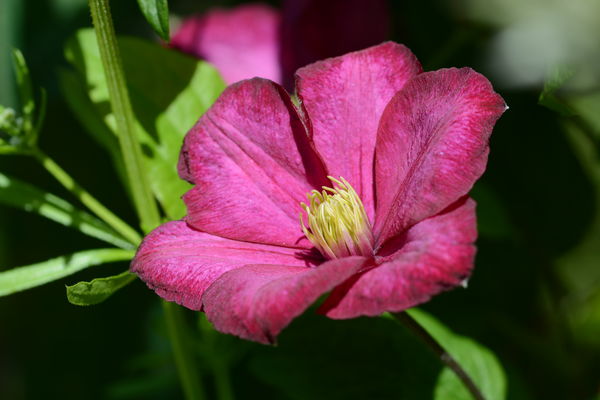Do you store your want to keep photos as Tiffs or Jpegs?
Jun 7, 2020 10:08:00 #
Brian S. wrote:
To store all of your inactive photos you should use at least two separate drive with identical copies of your photos.
All of your in-process photos should be stored on at least 2 two hard drives also.
You archives should at least be all Tiffs because you can make new Jpegs from a Tiff but Tiffs made from a Jpeg will be of poorer quality.
With the low prices of hard drives anymore 3 to 4 TB hard drives are a pretty inexpensive insurance policy.
All of your in-process photos should be stored on at least 2 two hard drives also.
You archives should at least be all Tiffs because you can make new Jpegs from a Tiff but Tiffs made from a Jpeg will be of poorer quality.
With the low prices of hard drives anymore 3 to 4 TB hard drives are a pretty inexpensive insurance policy.
Plus the cloud. If some catastrophe such as a major storm, or a fire that wipes out a large area then your primary storage and the backup could both be lost. By storing a copy in the cloud you insure that if the worst happens you always have a safe backup.
Why not just backup to the cloud? Because if you need to do a full restore it is quicker from an external drive. The cloud is your insurance police for the external drive.
Jun 7, 2020 10:09:13 #
Jun 7, 2020 10:51:03 #
Marturo
Loc: Western North Carolina
lsimpkins wrote:





Ok I see a lot of you feel this way.
Why then should I not shoot both raw & Jpeg
then store both? My jpegs for use then Raw
for any other PP needs.
I am just about to build my new Win 10 Desktop
& I wonder about storage.
Win 7 PC has 1/2 terra Byte
Win 10 PC will have 2 TBs
Main drive & 1/2 TB digital drive.
Even with all my photos my drive is
not full. I believe that Picasa stores
our photos in the cloud. Could be wrong.
Jun 7, 2020 11:06:02 #
Marturo wrote:
I ask because we all know that Tiffs are a better ... (show quote)
I don't entirely understand all this because of system differences. I have a Canon 650D (Rebel family) and a Hasselblad H2 with Phase One P-30 back, and use Photoshop Elements 12 for both.
When I put the Canon camera card into my desktop and open the pictures, they seem to be raw, and it asks if I want to open the image for editing. I believe it edits the image in raw format (without altering the original), and the raw image is visibly different from opening it in jpeg. It then saves it in the format I choose--often jpeg. I read that some editors won't accept photos except in raw format--unedited so they can examine and edit it themselves. I shoot in raw and jpeg, so that would not be a problem, if I can copy and send the raw.
But the Hassie is another story. I was told by many that the H2 with P-30 back must use the Phase One editing software, which is only accessible by monthly subscription--which in itself would rule out that camera for me. But someone said it can use the free Hasselblad editing software, Phocus. They were right, and I like Phocus--my editing skills are limited. But I also found immediately that PhotoShop soon included Phase One raw images in its software, and they appear in PhotoShop as tiff automatically. So within my systems it seems that when I read H2 images they are tiff format; I don't think I can access Phase One raw as such, or save it. It is on the Compact Card (therefore can be copied and saved), but I believe the Photoshop and Phocus both present it to me as tiff. Does that sound right? (But after I edit a tiff, I can save as jpeg or anything else.)
I am amateur and never sell pictures, but from reading pros here it seems that one can readily sell pictures in any format (with editing), so if anybody ever wanted to buy a photo from me, apparently they could.
Question: if you delete images on a memory card, is it empty like new, or are they just hidden in the card? Phase One lets you organize and save folders in the camera card, but that looked like more trouble than it was worth to me.
Jun 7, 2020 11:11:17 #
CHG_CANON wrote:
Every file you move to the cloud will have a touch of grey ...



(only on the underside.)
Jun 7, 2020 11:16:23 #
Charles 46277 wrote:
...
...
Question: if you delete images on a memory card, is it empty like new, or are they just hidden in the card? ...
...
Question: if you delete images on a memory card, is it empty like new, or are they just hidden in the card? ...
The file reference (name) is removed from the index (directory <File Allocation Table (FAT)>), allowing for the space it occupied to be used again (now free space, not empty, free, available). The file itself remains, that's why recovery programs work if you haven't subsequently written to the card (saved more pictures).
LOGICALLY it is empty, physically it is not.
Computers only care about logic. It's people who worry and want it empty empty.
Some format commands simply clear the FAT table, they don't erase it as the table always remains, it is just cleared. A low-level format sets all the file storage bits/bytes to either "1" or "0".
Not all format commands/processes are necessarily the same.
Jun 7, 2020 11:21:34 #
mwsilvers
Loc: Central New Jersey
Marturo wrote:
I ask because we all know that Tiffs are a better ... (show quote)
I store them as raw only and create Tiff and JPEG files as needed for distribution and sharing.
Jun 7, 2020 11:31:49 #
CHG_CANON wrote:
Every file you move to the cloud will have a touch of grey ...
But certainly a silver lining.
Jun 7, 2020 14:12:42 #
Longshadow wrote:
The file i reference /i (name) is removed from t... (show quote)
I'm not necessarily up to date on this, but the way it used to work is that the FAT would store the file name and the location of the first cluster containing the file. I don't know whether the location of all the clusters holding the file are stored or whether the first cluster points the the next one etc. Somehow the computer has to know which clusters are available for writing and the daisy chain might be problematical for that.
When you delete a file, the first character of the file name is changed to some character that tells the computer that you have erased this file. The rest of the file name is intact, and the first cluster has not been changed. If you want to undelete the file, you can do that by changing the first character of the file name back to something. That is how you can recover files if you accidentally delete them. Recovery software would show you the partial file name so you can figure out which files to undelete. Undelete won't work if between delete and undelete you write something else into the space containing the data from the file.
Not being a computer engineer, I would consider that an approximation of how it works. But it's based on my dim memory of searching for deleted files 30 years ago or more.
Jun 7, 2020 14:13:26 #
Jun 7, 2020 14:22:06 #
DirtFarmer wrote:
I'm not necessarily up to date on this, but the wa... (show quote)
I don't know about the first character thing, nor the details on how the FAT table is structured or works. There may be a flag in the table too. I never had to get into those details. I would just read existing file contents in either strings or the HEX data to work with it, but never from deleted files.
I can't remember when I last used any recovery software.
Jun 7, 2020 14:30:05 #
Marturo wrote:
I ask because we all know that Tiffs are a better ... (show quote)
LightRoom has all mine as the original RAW. Edits are mostly jpegs but some tiffs. Ones that have been posted I put a jpeg copy in a folder labeled with where I posted it so I can remember in case of future need.
Jun 7, 2020 14:42:43 #
Marturo
Loc: Western North Carolina
mwsilvers wrote:
I store them as raw only and create Tiff and JPEG files as needed for distribution and sharing.
Sounds like a plan.
Thanks to everyone for your replies, it really helps moving ahead.
Jun 7, 2020 14:50:24 #
Marturo wrote:
I ask because we all know that Tiffs are a better ... (show quote)
After initial processing of my RAW files in ACR, I do most of my editing in Photoshop in layers. So I save them as PSD files, which is just about the same as TIFF. JPEGs don't support layers, and I want to keep the layers in case I want to make changes later. I only make JPEGs if I am sending them to someone or for display on the web. Storage is cheap these days, so I don't worry about that.
Jun 7, 2020 15:42:36 #
cameraf4 wrote:
But certainly a silver lining.
And your skies will look awesome.
If you want to reply, then register here. Registration is free and your account is created instantly, so you can post right away.






